
A heat pump can not only be used to heat a house, but also to heat domestic water. In fact, heat-pump water heaters are among the most efficient type of water heaters on the market today.
One of the interesting things about a heat-pump water heater is its versatility. In a hot climate, it is best practice to place the heat pump indoors. This way, it will pull heat from inside the house and use it to heat the water. In a cold climate, however, it is best to put the heat pump either in a garage or use ducts so it draws air from the outside. This way it doesn’t steal any heat from inside the house.
Because I live in a colder climate, I decided to place my heat-pump water heater indoors and duct it to the outside. This allows me to have the best of both worlds. The heat is drawn from the outside, so it doesn’t steal precious heat from inside the house, yet the tank of hot water is indoors; if any heat escapes from the tank it will only make the house warmer.
I bought a hybrid heat-pump water heater. Much like a hybrid vehicle, which has the ability to either power itself with gasoline or a charged battery, the hybrid water heater can heat water with either the heat pump, or a traditional electric heating element. Ideally, one would select the proper setting to run the hybrid water heater in only-heat-pump mode, and utilize the traditional heating element only in the extreme event that outside air is too cold for the heat pump to function.
The Rheem heat pump is able to function properly even at 37°F. While there are definitely days here where the temperature drops below 37°F, it is quite rare that the high temperature for the day is below that. Since the water heater has a 50-gallon tank, it only needs to function for a few hours a day to heat the water in the tank. As long as the temperature is above 37°F for a few hours each day it should operate just fine on the heat pump setting. That having said, it is always nice to have a backup plan.
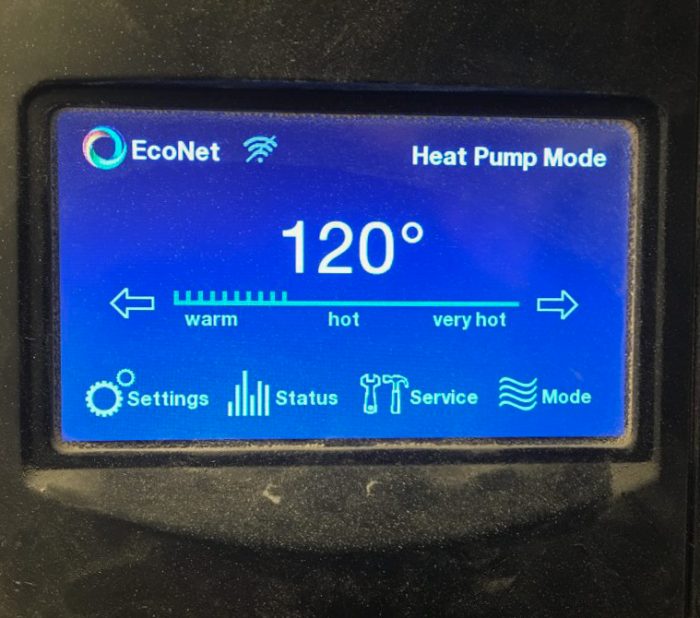
Installing the water heater
Installation of a heat-pump water heater is basic plumbing, electrical, and HVAC all in one. The first step is to run the water lines. Way back when I ran the PEX for the water supply lines in the house, I had run a line from the main supply, formed it into a loop in the utility room, and then into a manifold. From this manifold, I ran PEX to every fixture needing hot water in the house.
The loop was necessary for this very step. I cut the loop, and attached one side of it to a flexible metal line that ran to the hot water outlet on the water heater. Building codes in my area do not allow PEX to be connected directly to the water heater so the 18-inch-long flexible metal is necessary. I ran the other side to an expansion tank, then to a shutoff valve, and then into the flexible metal for the cold water inlet of the water heater.

The expansion tank is important to allow room for the water to expand and contract as it heats and cools. As we learned when discussing the heat pump, the volume and temperature of a liquid are directly related, so when the temperature of a liquid rises, so does its volume. Without an expansion tank, the water in the supply lines will create excess pressure as it is heated and cools and can cause the PEX to deteriorate faster.
I installed the waste lines next. Earlier in the build, when I was installing the DWV plumbing for the house, I had installed an indirect waste receptor in the utility room. An indirect waste receptor is simply an open pipe with a trap to ensure that sewer gases don’t run out of it. As you can see below, the code allows waste lines into the open pipe as long as they have an air gap. This ensures that if for whatever reason the pipe gets full of water, no water can be siphoned out of the pipe by one of the waste lines.
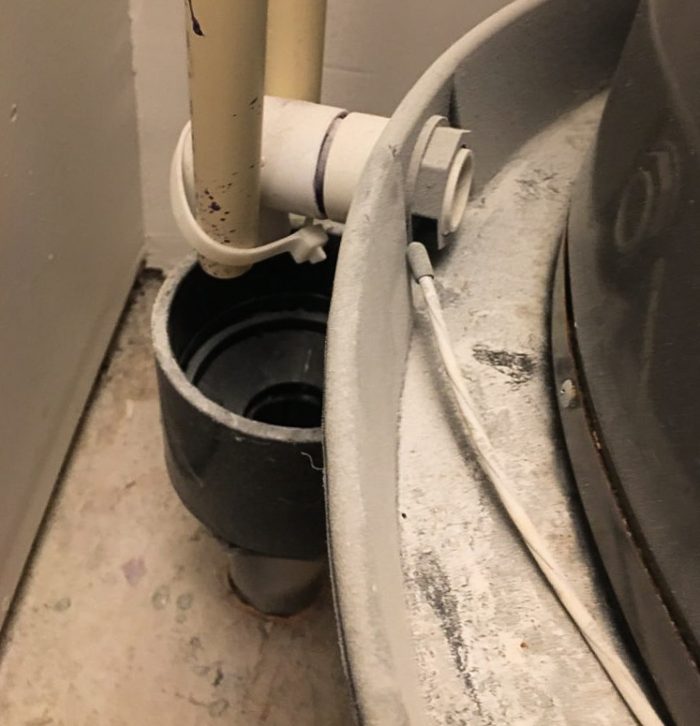
I directed a total of three waste lines into the receptor. The first was from the drain pan, which I had placed the water heater in. The second was from the condensate line. All heat pumps create a fair amount of condensation due to the temperature changes and the heat-pump water heater is designed to catch that condensate and direct it towards this pipe.
The last waste line was for the temperature/pressure relief valve. This valve is found on all modern water heaters. If for whatever reason the pressure or temperature in the water tank gets too high, the valve will open and release the pressure by directing water into the pipe. Without this valve, pressure could possibly get so high in the tank that it would rupture, and scalding hot water would be released.

The next part of the installation was to install the electrical wiring. I had already run a 30-amp circuit to the utility room way back when I did all of the wiring for the house, so it was simply a matter of connecting some conduit to the box, running wire through it, and connecting the wires.
The last step was to install the ductwork. I had already installed the vents for both the intake and exhaust for the water heater, using the same vents that I had used for the ERV. All that was left now was to simply connect one end of some insulated flexible duct to the vent, and the other end to the water heater.
This is one in a series of blogs detailing the construction of a net-zero-energy house in Point Roberts, Washington, by owner-builder Matt Bath. You’ll find Matt’s full blog, Saving Sustainably, here. If you want to follow project costs, you can keep an eye on a budget worksheet here. All photos courtesy of the author.
Previous posts by Matt Bath:
Designing and Installing a Septic System
Installing the Ventilation System
Weekly Newsletter
Get building science and energy efficiency advice, plus special offers, in your inbox.





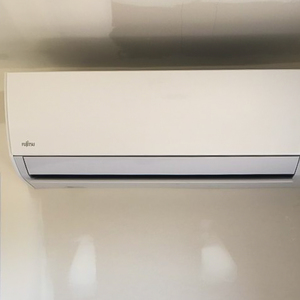
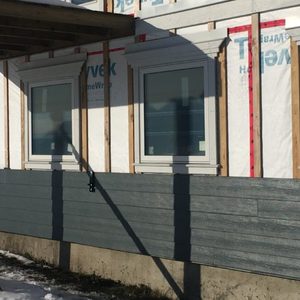
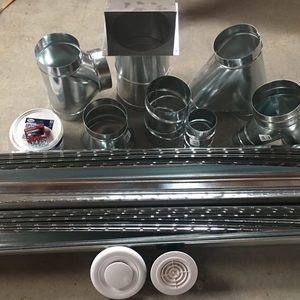
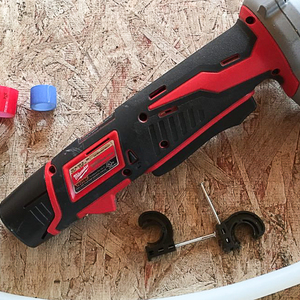






27 Comments
>"Because I live in a colder climate, I decided to place my heat-pump water heater indoors and duct it to the outside. This allows me to have the best of both worlds. The heat is drawn from the outside, so it doesn’t steal precious heat from inside the house, yet the tank of hot water is indoors; if any heat escapes from the tank it will only make the house warmer. "
In most climates that would be a false economy. The efficiency of a heat pump water heater with 40F air is substantially lower than it's nameplate UEF, and way lower than heat provided by a space heating heat pump using the same outdoor air.
And in the more humid "-A" climate zones using outdoor air gives up the substantial amount of latent-cooling the water heater would provide during the shoulder seasons & cooling season. If your house needs a dehumidifier or AC to keep the place comfortable and avoid the "musty basement" smell, a heat pump water heater fully indoors would carry most of that dehumidification load. That's a bit less of an issue in temperate low-average dewpoint Point Roberts, WA, (zone 4C) but it doesn't hurt.
There are plenty of published efficiency (including grid efficiency) studies of heat pump water heater configurations in the PNW in the NEEA and WSU databases, eg:
https://neea.org/img/uploads/heat-pump-water-heater-field-study-report.pdf
https://neea.org/our-work/advanced-water-heating-specification
http://www.energy.wsu.edu/Documents/Final%20Report%20-TIP%20302%20-%20DR%20Assessment%20of%20CO2%20HPWH.pdf
http://www.energy.wsu.edu/Documents/Final%20Report%20TIP%20292_Dec%202015.pdf
Was thinking the same, Dana. I can't think of a reason in any climate to vent a HPWH to the outdoors. It is confusing, though, since Rheem's own literature recommends external venting in cold climates.
I'm looking at this same water tank for my build, and for the same reasons you mentioned. I'm on the colder side of 6A and the year-round dehumidification will be welcome. In fact, I'm planning a large ducted plenum that will supply hot/humid air to the water heater from the ceiling of our south-facing open 2 story plan, and return the cooled/dehumidified air to the same space. Since showers are mainly taken in the morning hours the heat pump will be working throughout the day, heating water with the solar gains from our south facing windows.
Dana, thoughts about ducting inlet air from an unconditioned attic? We've been considering that if we get a Rheem HPWH, since that air should generally be warmer than outside air for most, if not all hours in a day. And looking at ways to select -- perhaps with a duct damper -- whether the cold exhaust air is directed indoors or outdoors depending on seasonal factors (we're in Climate Zone 3C).
That is, unless we go the Sanden route, should we find a way to get installation costs down below the stratospheric one-percenter level.
What you are proposing is to essentially use your roof as an un-glazed solar collector, which works-mostly OK in a 3C climate
But drawing air from a vented attic and ducting the cold air into the conditioned space pressurizes the house, driving conditioned air out of the house, pulling outdoor air into the attic, which isn't necessarily what you want to do. Exhausting the cooler drier air back into the attic will lower the roof deck temperature (lowering the net sensible cooling load on the house) and lower the moisture content of rafters & roof deck.
Dana, good point. Looks like the air flow can be 165-25o cfm when it's operating. Realizing possible dependencies on variables, in general would it be better to draw and exhaust air from the living space, if the HPWH has to be situated there? Unless a Sanden, of course.
It seems reasonable to expect a HPWH to operate when someone is having a shower so at one to two hundred cfm it could be used to vent the bathroom. In the winter if the HPWH is also used for underfloor heating then it might be operating enough to provide fresh air if used in conjunction with anERV. I would vent it to the exterior. Thoughts?
Venting the bathroom could work, but at 4200 BTU/hr it takes the heat pump quite a long time to recover. A 10 minute shower at 2.5 GPM and 90 degree water temp rise will see the heat pump run for over four hours.
A HPWH should probably be all vented to/from the exterior (intake and exhaust), or kept all internal to the envelope. Venting the exhaust and drawing from interior conditioned space will drive a lot of infiltration.
So in a cold climate the options for a HPWH are to either pull cold air from outside, and decrease the COP considerably, or use the ambient interior air, which is already being heated by the furnace. Although it seems that the latter option is better, I wonder how we could estimate the actual efficiency of the HPWH in this scenario, since we are in essence stealing heat from the furnace and pushing it into the hot water tank. In other words, if the space heating is done using an air source heat pump with a COP of 3, and the HPWH has a COP of 3, what is the overall efficiency of the HPWH?
I work with an environmental non-profit, managing a demonstration house for sustainable renovation options, and we recently installed a Rheem HPWH hybrid unit like the one in this article. I have wondered about the difference between interior and exterior venting as well, since the unit can be vented either way. I would love to be able to give visitors an accurate assessment of the differences. We also have a gas-fired tankless water heater in the house, so I have been switching over to use that in the winter, and only using the HPWH in the summer, which seems like it might be the most efficient way to go. But if the tankless unit is only 95% efficient, perhaps the HPWH would actually be more efficient even in the winter. I'm not sure how to calculate the difference, however. Thoughts?
Since you have both, it is probably most efficient to use the gas heater in winter and the HPWH in summer as you describe. But most of us don't want to pay for two appliances when one will do. The ROI moves very far out. The HPWH absolute efficiency certainly decreases in winter when it "steals" heat from the already heated house. But it does far better the rest of the year and on balance, is worth the investment IMHO. A gas fired tankless is always only 95% efficient (or significantly less).
Actually, I'm more interested in the calculation of the overall efficiency of the HPWH when it's "stealing" from the furnace in the winter. If the COP of the HWPH is 3.5, for instance, and the efficiency of the furnace is 95%, then the net efficiency of the HPWH is still going to be somewhere in between 95% and 350% (probably around 330% or COP of 3.3), which is much higher than the 95% efficiency of the tankless WH. In this particular case, the furnace is actually a ground source heatpump with a COP of about 3.5, so the net efficiency of the HPWH is still in the 3.5 range.
Since the heat energy is coming from the furnace at 95%, the whole process cannot be more efficient than that.
At a COP of 3.5, 29% of the energy to heat the water is coming from the electricity driving the heat pump, and 71% is transferred from the conditioned space. Therefore, compared to a 95% efficient gas water heater, the HPWH would be 95% x 0.71 = 67.5%
I'm pretty sure that math is correct. Someone please correct me if I've missed something.
It's less efficient than a standalone 95% gas water heater since it's costing a significant amount of electricity to simply move the heat from the air to the water. Transferring heat from gas directly to water (as in a 95% water heater) skips the heat pump stage, which represents a 29% penalty.
“[Deleted]”
Lance Peters, how did you get the 29% and the 71%?
That's from the 3.5 COP of the HPWH. 1 unit of heat energy comes from the electricity used by the heat pump, and 2.5 units come from energy scavenged from the air. 1/3.5 = 29% and 2.5/3.5 = 71%
Re-reading my comment, it's not correct. Penalizing the process by 29% would be accurate only if the electricity used to drive the heat pump was being wasted. It's not being wasted, it's going into the water as heat.
The total efficiency then becomes complicated, because most of that electricity will be going into heating the water. I don't think it's 100% efficient at using that electricity like a standard electric element tank would be, but it's probably close. Let's assume 95% just to keep things simple.
So if we remove the heat scavenged from the environment when looking at the HPWH and assume it's electric heat efficiency is 95%, then the total efficiency of the process would also be 95% since the furnace is also 95% efficient.
What you've got now is 29% of your water heat coming from electricity and 71% of your heat coming from gas. Assuming you pay more per BTU for electricity than gas, the relative pricing will indicate how much more you're paying for your hot water than if using a straight 95% efficient gas water heater.
I bet the difference is very small, especially when you weigh in the dehumidification and cooling benefits of the HPWH in the shoulder and cooling seasons. Even where I am on the colder side of CZ6A here in Canada, I still think the benefits of the HPWH sound like an overall win.
Lance,
There are problems with both of your models. The reality of this is more complex, because you have to come up with a conversion between efficiency of two different fuel sources. For example, a 95% gas furnace is theoretically less efficient than a 100% electric heater, the cost of equal quantities of energy of gas and electricity are far different. If you're looking at carbon equivalents instead of cost, you would have to factor in the processing and power generation into the equation.
In simplest terms for Brendan's scenario, in winter the HPWH is stealing desirable room heat from the furnace. So if you calculate how much electrical energy it's using, that amount of energy is effectively going into space heating (vs having a gas water heater), either by directly going into the water or by mechanical losses to the environment that become heat. I'm not sure there's a formula that could spit out an equivalent efficiency number, as I think it varies depending on hot water use and heating demand. I could be wrong about that, maybe those variables cancel each other out.
Trevor, I agree completely. Looking at efficiency this way doesn't get into much detail and is kind of worthless, but I figured it at least kept the theme of the original question which was regarding the COP of a heat pump working in a home heated with gas.
Comparing cost would be the most obvious output, for which you need to consider the cost/BTU for each fuel source, which is why I stuck with strictly efficiency, but only efficiency within the building. From the source it gets more complicated, or carbon impact.
Then, as you suggested, there's the other stuff. The EF of a resistance water tank it's much less than 100%, how efficient is the ductwork/fan in the gas furnace... So many scenarios would have to be tested to get an accurate "use-over-time" calculation that it just might not be worth worrying about when you consider the small differences in energy involved.
I hadn't yet seen a good expansion on this scenario so I decided to take a crack at the math myself. Admittedly a very simplistic approach that omits a ton of variables, but I feel a little better thinking through the process and having a reasonable confidence that I'm at least in the ballpark. If a study is released showing I'm completely wrong, well, that's the way these things go! :)
How is 37 F cold??
The average high is colder than 37 F for more than 33% of the year where I live...
It's all relative. But yeah, I wasn't expecting that when I started reading that sentence either.
I'm getting ready to install the same water heater (literally moved it into the house yesterday) and I'm figuring out some details before finishing my installation.
-The manual lists a "6" Heat Trap" between the water heater and expansion tank, it looks like you didn't put that in, reasoning/thoughts on heat traps?
-It looks like you put a plywood box underneath the water heater, is that to get it off the floor for thermal reasons? or to let the drain pan gravity drain to the waste receptor ?
Is the expansion tank necessary? If the water expands or contracts, then the water supply to the house will buffer it. Do you have a check valve on the supply or something that prevents the water from pushing back on the house supply?
It's code in some areas. Why I don't know, but it is. We don't them here, and it's never been a problem.
I think if there is any sort of upstream check valve in the system the pressure could be trapped in the house and spike if there is no expansion tank. This stresses the tank. Not sure if water meters include a check valve or not.
Many local water utilities have boosted the water pressure to force more water through the pipes. If the incoming pressure exceeds 80 psi or so, a pressure reducing valve is needed. While these are not designed as check valves, they do have that effect. Any home with a PRV (or other check valve) on the main requires an expansion tank somewhere in the system.
I installed the 65 Gal Rheem water heater about a year and half ago and so far I'm very happy with it. I leave it in heat pump only mode year round and even run a small heat loop off of it for a radiant slab. The unit is installed in an unconditioned basement that hovers around 40* F in the winter so I ducted the intake to the finished side of the basement to help with efficiency. The econet app says it uses about 7KWH/day with the slab heat on, and about 1-2 KWH/day for the rest of the year with the slab off. I know its not really designed or recommended to be used for space heating but thats kinda why I wanted to try it and I'm pretty impressed, although it does run quite a lot with the slab heat turned on. I Definitely recommend this water heater.
I'm planning to purchase a Rheem HPWH for our building, and have thought about implementing a similar set up, using it for hot water with a loop for our hydronic radiant system, or possibly getting the radiant its own water heater. It's encouraging to hear that its working well for you. Curious how large the slab is, and what climate zone you are in?
Keep in mind a HPWH takes heat from the house and puts it into the water. Heating a slab might work, but you'd be stealing heat from the rest of the house to do it. Also, the heat pump in the Rheem is only 4200 BTUs, so if the slab puts much demand on the water heater it might have trouble keeping up in Heat Pump mode.
It would be fantastic if there were "short" versions of these. I can't fit any of the existing brands (Rheem, AO Smith, Stiebel Eltron) into my conditioned crawlspace because the shortest model is over 60 inches tall.
Matt, how is the recovery time with that model? Did you select the same tank size as you would for a standard resistance heater?
Log in or create an account to post a comment.
Sign up Log in